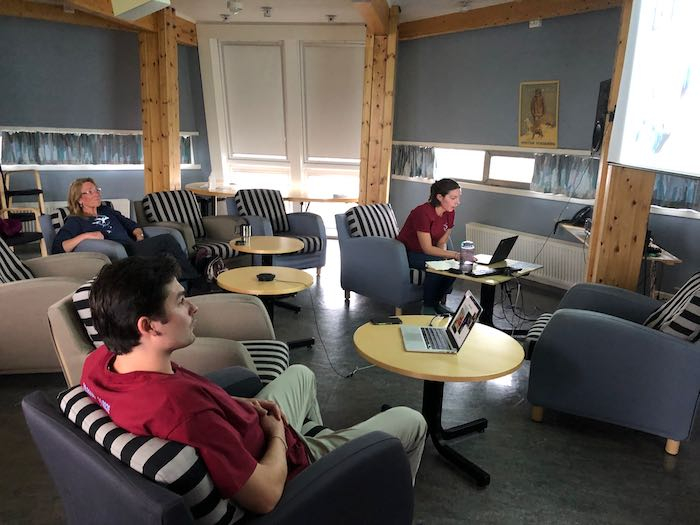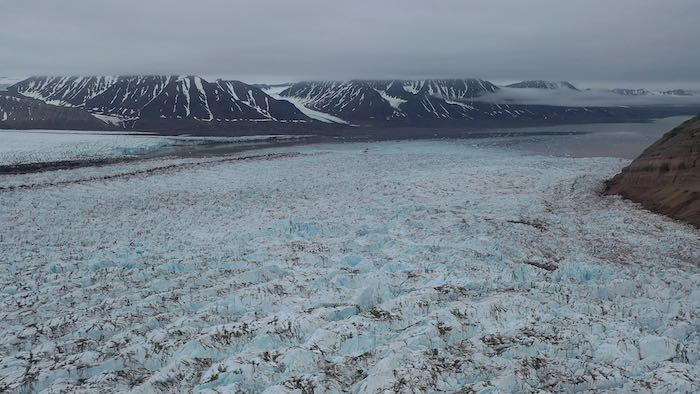The past two days have been spent wrapping up the field work and winding things down. Tomorrow we pack up the equipment, and on Thursday we fly back to Longyearbyen to begin our travels home.
The weather improves
Yesterday the day started foggy (like Sunday) but it cleared up and we ended up doing some field work. Although the fjord was really choked with ice, which made finishing up the bathymetry work a challenge.
 The view yesterday morning which ended up being a beautiful day after a foggy start. Although the ice wasn’t too bad at this point, it got worse and worse as the day went on!
The view yesterday morning which ended up being a beautiful day after a foggy start. Although the ice wasn’t too bad at this point, it got worse and worse as the day went on!
We were able to do a couple more CTD casts and a drogue measurement, to monitor the plume velocity coming out of Kongsvegen Glacier. It seems like the flow velocity off that glacier is still low. We do expect that to change any day - especially when a large supraglacial lake (a lake that forms from meltwater on top of the glacier) several kilometers up the glacier decides to drain itself. Unfortunately we will not be here to witness that.
However, we did witness another large iceberg calving event with a huge wave. Check out this video I took of that!
 A large calving event in front of Kongsvegen Glacier. The wave was pretty large from this one!
A large calving event in front of Kongsvegen Glacier. The wave was pretty large from this one!
I was also able to do some drone work to monitor the sediment plumes coming off of Kongsvegen and Kronebreen.
 The brown, ice free water that is visible from the drone shows where sediment-laden water is coming off the glacier in a sediment plume.
The brown, ice free water that is visible from the drone shows where sediment-laden water is coming off the glacier in a sediment plume.
 You can see the sediment plume coming off Kongsvegen glacier wherever there are no icebergs. The icebergs are pushed out of the way by the plume.
You can see the sediment plume coming off Kongsvegen glacier wherever there are no icebergs. The icebergs are pushed out of the way by the plume.
Last night we had our live Zoom “Polar Connect” event. It was great to see so many of my students, our family members, other PolarTREC teachers and other interested people. We really enjoyed presenting, and the questions were great! (If you couldn’t attend the webinar, it was recorded and archived. The link for the recording will be available shortly.)
 Our team presents at our live Zoom event. At this moment Kelly is presenting while Xander monitors the chat.
Our team presents at our live Zoom event. At this moment Kelly is presenting while Xander monitors the chat.
A great hike and views of the ice sheet
This morning we had a little excitement during breakfast. We were able to witness an Arctic fox hunting a group of geese. One little fox proud walked by the cafeteria with a goose in its mouth! I was only able to get a few seconds of video, but here it is.
Today the fjord was so full of ice that doing bathymetry or oceanography work was not really possible. If there are too many small icebergs floating in the water, it’s too risky for the equipment. But we were able to drive the boat slowly over to Collethøgda Mountain, where Xander and I took a long hike while Julie and Kelly tried unsuccessfully to do some bathymetry. There’s no trails to hike, so you just make your way up the best way you can across the glacial debris. We had consulted with some other scientists who told us a good way to the top, but we missed the turnoff which would have led us to the top. So we were only able to go about halfway up, but we went all the way to the back of the mountain where we had some incredible views, ate our lunch, and I flew the drone to capture the scene.
Check out this video I took which shows you how magnificent the scenery was from the back of Collethøgda.
 Here I am on a moraine on Collethøgda Mountain looking over Kongsbreen and Kronebreen Glaciers.
Here I am on a moraine on Collethøgda Mountain looking over Kongsbreen and Kronebreen Glaciers.
 Xander and me at the end of our hike today.
Xander and me at the end of our hike today.
The view from Collethøgda allowed us to see much further back along Kronebreen and Kongsbreen Glaciers. What becomes obvious from that vantage point is how all these glaciers connect into a huge ice sheet that covers most of the interior of the island that we’re on (Spitsbergen, the largest of the Svalbard islands). The immense amount of ice was breathtaking as glaciers were visible from all directions.
 The view down Kronebreen Glacier from Collethøgda Mountain.
The view down Kronebreen Glacier from Collethøgda Mountain.
 If you look closely you can see Xander and me; this picture was taken from the drone!
If you look closely you can see Xander and me; this picture was taken from the drone!
Looking down on the glaciers also allowed us to see meltwater features - small supraglacial lakes, moulins (where water flows down in holes in the glacier) and streams. When we think about the sediment plumes that we are monitoring at the glacier faces, the source of much of that water is all the meltwater we see on top of and next to the glaciers. It was also really interesting to see the difference in texture between Kronebreen, which has deep crevasses and many small lakes - and Kongsbreen, which has much tighter crevasses and many small meltwater channels but no visible lakes. This can be explained (I think) because Kongsbreen, which is now almost entirely grounded on land, is flowing much more slowly than Kronebreen.
 Some of the meltwater lakes on Kronebreen glacier. The scale is difficult to gauge here - I would estimate that the largest lake in this image is at least 200-300 meters long.
Some of the meltwater lakes on Kronebreen glacier. The scale is difficult to gauge here - I would estimate that the largest lake in this image is at least 200-300 meters long.
 Meltwater channels forming on the top of Kongsbreen Glacier. Notice how different the texture of Kongsbreen is from Kronebreen.
Meltwater channels forming on the top of Kongsbreen Glacier. Notice how different the texture of Kongsbreen is from Kronebreen.
So here we are, about to pack up and go home. It’s too early to say what our data is telling us, especially as we still need to look back to previous years to compare and look for patterns. But we have learned a great deal nonetheless. Tomorrow will be a packing day, and maybe we’ll have time to do a short hike behind Ny Ålesund.
I will continue to monitor the blog, and will probably write at least another post or two. But keep the comments coming, even as our work slows down.
 Xander and my boots after our muddy hike up Collethøgda
Xander and my boots after our muddy hike up Collethøgda

Comments
Add new comment